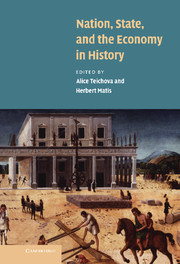Book contents
- Frontmatter
- Contents
- List of figures
- List of tables
- List of contributors
- Acknowledgements
- Introduction
- PART I
- PART II
- 7 The state and economic development in Central and Eastern Europe
- 8 Concepts of economic integration in Austria during the twentieth century
- 9 The economy and the rise and fall of a small multinational state: Czechoslovakia, 1918–1992
- 10 Economic retardation, peasant farming and the nation-state in the Balkans: Serbia, 1815–1912 and 1991–1999
- 11 National and non-national dimensions of economic development in nineteenth- and twentieth-century Russia
- PART III
- PART IV
- PART V
- Index
8 - Concepts of economic integration in Austria during the twentieth century
Published online by Cambridge University Press: 07 September 2009
- Frontmatter
- Contents
- List of figures
- List of tables
- List of contributors
- Acknowledgements
- Introduction
- PART I
- PART II
- 7 The state and economic development in Central and Eastern Europe
- 8 Concepts of economic integration in Austria during the twentieth century
- 9 The economy and the rise and fall of a small multinational state: Czechoslovakia, 1918–1992
- 10 Economic retardation, peasant farming and the nation-state in the Balkans: Serbia, 1815–1912 and 1991–1999
- 11 National and non-national dimensions of economic development in nineteenth- and twentieth-century Russia
- PART III
- PART IV
- PART V
- Index
Summary
THE ECONOMY AND THE NATIONAL PROBLEM OF THE LATE HABSBURG EMPIRE
In Austrian history a particularly contradictory development can be observed. On the one hand, the various provinces of the Habsburg monarchy became part of one economy in the course of the nineteenth century. On the other hand, nationalist movements, based mainly on common language or national consciousness, arose about the same time. They strongly ran counter to the collective consciousness of belonging to a common state. Although these movements were not always disloyal to the monarchy, they developed very different ideas about the economy that only partly went along with the existence of the customs union of 1850. For example, the Hungarian Independence Party called not only for sovereignty of the Hungarian state, but also for economic independence, which mainly meant protective duties for Hungarian industry and a separate Hungarian customs area. Also Austrian agriculturists demanded a customs division between Austria and Hungary, in order to protect themselves against the strong competition of Hungarian agriculture.
Nevertheless, the customs union had existed before and continued to exist after the Austro-Hungarian Compromise of 1867. Therefore, trade agreements were negotiated and signed by the common imperial and royal foreign ministry. The Zoll- und Handelsbündnis (customs and trading union) and the monetary union obviously were in the interest of the dominant economic and social groups of the 1860s, which consisted of Hungarian agrarian big business and Austrian industry (mainly German-Bohemian, German-Moravian and Lower Austrian).
- Type
- Chapter
- Information
- Nation, State and the Economy in History , pp. 159 - 180Publisher: Cambridge University PressPrint publication year: 2003
- 3
- Cited by



